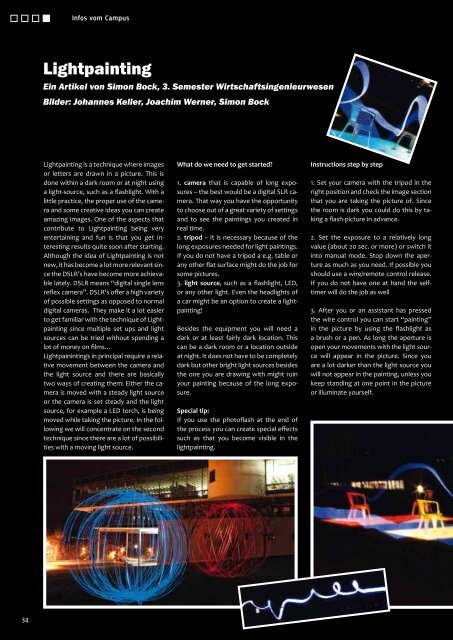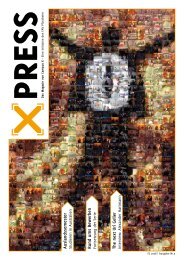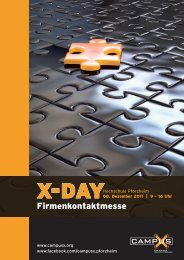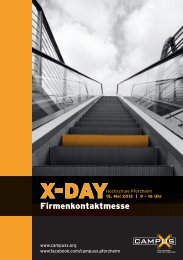London Transportation Design Light Painting ... - Campus X
London Transportation Design Light Painting ... - Campus X
London Transportation Design Light Painting ... - Campus X
Sie wollen auch ein ePaper? Erhöhen Sie die Reichweite Ihrer Titel.
YUMPU macht aus Druck-PDFs automatisch weboptimierte ePaper, die Google liebt.
Infos vom <strong>Campus</strong> Infos vom <strong>Campus</strong><br />
<strong>Light</strong>painting<br />
Ein Artikel von Simon Bock, 3. Semester Wirtschaftsingenieurwesen<br />
Bilder: Johannes Keller, Joachim Werner, Simon Bock<br />
<strong>Light</strong>painting is a technique where images<br />
or letters are drawn in a picture. This is<br />
done within a dark room or at night using<br />
a light-source, such as a flashlight. With a<br />
little practice, the proper use of the camera<br />
and some creative ideas you can create<br />
amazing images. One of the aspects that<br />
contribute to <strong>Light</strong>painting being very<br />
entertaining and fun is that you get interesting<br />
results quite soon after starting.<br />
Although the idea of <strong>Light</strong>painting is not<br />
new, it has become a lot more relevant since<br />
the DSLR’s have become more achievable<br />
lately. DSLR means “digital single lens<br />
reflex camera”. DSLR’s offer a high variety<br />
of possible settings as opposed to normal<br />
digital cameras. They make it a lot easier<br />
to get familiar with the technique of <strong>Light</strong>painting<br />
since multiple set ups and light<br />
sources can be tried without spending a<br />
lot of money on films…<br />
<strong>Light</strong>painintings in principal require a relative<br />
movement between the camera and<br />
the light source and there are basically<br />
two ways of creating them: Either the camera<br />
is moved with a steady light source<br />
or the camera is set steady and the light<br />
source, for example a LED torch, is being<br />
moved while taking the picture. In the following<br />
we will concentrate on the second<br />
technique since there are a lot of possibilities<br />
with a moving light source.<br />
What do we need to get started?<br />
1. camera that is capable of long exposures<br />
– the best would be a digital SLR camera.<br />
That way you have the opportunity<br />
to choose out of a great variety of settings<br />
and to see the paintings you created in<br />
real time.<br />
2. tripod – It is necessary because of the<br />
long exposures needed for light paintings.<br />
If you do not have a tripod a e.g. table or<br />
any other flat surface might do the job for<br />
some pictures.<br />
3. light source, such as a flashlight, LED,<br />
or any other light. Even the headlights of<br />
a car might be an option to create a lightpainting!<br />
Besides the equipment you will need a<br />
dark or at least fairly dark location. This<br />
can be a dark room or a location outside<br />
at night. It does not have to be completely<br />
dark but other bright light sources besides<br />
the one you are drawing with might ruin<br />
your painting because of the long exposure.<br />
Special tip:<br />
If you use the photoflash at the end of<br />
the process you can create special effects<br />
such as that you become visible in the<br />
lightpainting.<br />
Instructions step by step<br />
1. Set your camera with the tripod in the<br />
right position and check the image section<br />
that you are taking the picture of. Since<br />
the room is dark you could do this by taking<br />
a flash-picture in advance.<br />
2. Set the exposure to a relatively long<br />
value (about 20 sec. or more) or switch it<br />
into manual mode. Stop down the aperture<br />
as much as you need. If possible you<br />
should use a wire/remote control release.<br />
If you do not have one at hand the selftimer<br />
will do the job as well<br />
3. After you or an assistant has pressed<br />
the wire control you can start “painting”<br />
in the picture by using the flashlight as<br />
a brush or a pen. As long the aperture is<br />
open your movements with the light source<br />
will appear in the picture. Since you<br />
are a lot darker than the light source you<br />
will not appear in the painting, unless you<br />
keep standing at one point in the picture<br />
or illuminate yourself.<br />
34 X-PRESS | WS 09/10<br />
35











